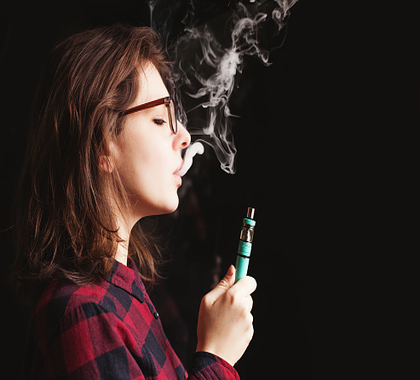Myth:
In August 2019, public health officials in several states reported an increase in young people being hospitalized due to lung illnesses believed to be caused by vaping. Health departments in Illinois, Minnesota, New Jersey, New York, North Carolina, Texas, and Wisconsin have issued health warnings against e-cigarette. Indeed, the Wisconsin Department of Health Services is urging “Wisconsinites to avoid vaping and e-cigarettes.”[i] CNN reported more than 120 cases in 15 states.[ii]
Reality:
Although young Americans are being hospitalized after using so-called vaping devices, they are actually using black market products that are not regulated and contain countless unknown chemicals. Indeed, none of the health departments have identified a single legal, regulated vaping product that could be causing adverse health effects. However, Wisconsin DHS did note the likely substances causing the hospitalizations include “nicotine, [tetrahydrocannabinol] THC, synthetic cannabinoids, or a combination” of these illicit substances.[iii]
Moreover, teenagers being hospitalized due to vaping marijuana products is not a new phenomenon. In January, three teens in Indiana were hospitalized after smoking “THC vape pens that were laced with an unknown substance.”[iv] In the same month, six high school students in New Mexico were hospitalized “after vaping marijuana wax.”[v] In 2018, the U.S. Army warned of the dangers of vaping synthetic marijuana. This occurred after more than 90 military personnel were hospitalized (two died) after vaping synthetic marijuana.[vi]
The black market for THC-related vaping products is thriving, which makes it difficult for regulators to address. For example, anyone can buy empty boxes of a popular marijuana vape brand on Amazon and eBay.[vii] [viii] Further, empty cartridges, which can be filled with any illicit substance, are widely available. YouTube even offers video tutorials on how to make THC oil that can be used in a vaping device.[ix] [x] [xi]
Currently, the U.S. Food and Drug Administration (FDA) regulates all legal e-cigarettes and vaping devices. FDA requires all products being sold to have been on the market prior to August 8, 2016 and registered with FDA by December 31, 2016.[xii] More pointedly, e-cigarette companies were required to submit ingredient listings to FDA by November 8, 2018.[xiii] Companies must also submit a report of harmful and potentially harmful constituents by November 8, 2019.[xiv]
Further, in New York, beginning December 1, 2019, all e-cigarette retailers must be licensed to sell vapor products.[xv]
Policy Message
Point 1: Recent headlines report there is an increase in hospitalizations due to vaping but health departments cannot identify a specific legal, regulated product that could have caused adverse health effects.
Point 2: There is a thriving illegal black market for empty cartridges and boxes that can be easily filled with illegal, unregulated substances.
Point 3: Synthetic marijuana and THC vape pens have sent teenagers to the hospital in states where recreational marijuana is illegal.
Point 4: Lawmakers should refrain from restricting access to legal e-cigarette products that are regulated by FDA.
* * *
For more information, contact Lindsey Stroud at 757/354-8170 or by e-mail at [email protected]. Or you can visit our website at www.heartland.org.
[i] Wisconsin Department of Health Services, “New Cases Identified in Investigation of Lung Disease Among Teens and Lung Adults Who Reported Vaping,” August 2, 2019, https://www.dhs.wisconsin.gov/news/releases/080219.htm.
[ii] Michael Nedelman, “CDC, state health officials investigating link between vaping and severe lung disease,” CNN, August 19, 2019, https://www.cnn.com/2019/08/17/health/vaping-lung-disease-states/index.html.
[iii] Wisconsin Department of Health Services, “Older Age Groups Now Included in Investigation of Lung Disease Among People Who Reported Vaping,” August 8, 2019, https://www.dhs.wisconsin.gov/news/releases/080819a.htm.
[iv] Meghan McRoberts, “Three Martin County students hospitalized after smoking vape pens, laced with unknown, harmful substance,” RTV6 Indianapolis, January 9, 2019, https://www.theindychannel.com/news/national/vape-pens-laced-with-unknown-substance-students-overdose.
[v] KRQE, “Vaping scare sends New Mexico high schoolers to hospital,” January 24, 2019, https://www.krqe.com/news/new-mexico/vaping-scare-sends-new-mexico-high-schoolers-to-hospital/.
[vi] Janissa Delzo, “Vaping With Fake Pot Leads to Two U.S Amy Deaths and Dozens of Hospitalizations,” Newsweek, February 1, 2018, https://www.newsweek.com/vaping-fake-pot-army-deaths-hospitalizations-797630.
[vii] Amazon, “Black Dank Vape Packaging – Empty Packaging – 100pcs for $49.99-32 Different Packaging,” https://www.amazon.com/Black-Dank-Vape-Packaging-Different/dp/B07NTSKHVM/ref=sr_1_3?crid=2WQM4QKIBDM0A&keywords=dank+vapes+packaging&qid=1566257900&s=gateway&sprefix=dank+vape%2Caps%2C171&sr=8-3.
[viii] eBay, “500 dank Retail packaginbagsFree Terps with order,” https://www.ebay.com/itm/500-dank-Retail-packaging-bagsFree-Terps-with-order/254333743831?hash=item3b3778f2d7:g:MHUAAOSw2QtdSz2R.
[ix] Amazon, “empty vape cartridges for oil,” https://www.amazon.com/s?k=empty+vape+cartridges+for+oil&crid=3C1JU9MDMNW6Z&sprefix=empty+vape%2Caps%2C168&ref=nb_sb_ss_i_2_10.
[x] eBay, “empty vape cartridge,” https://www.ebay.com/sch/i.html?_from=R40&_trksid=m570.l1313&_nkw=empty+vape+cartridge&_sacat=0.
[xi] “How to Make Your Own THC Oil Cartridges 510,” Vape Fuse, YouTube, April 30, 2019, https://www.youtube.com/watch?v=KQnKmEU5jPE&t=109s.
[xii] U.S. Food and Drug Administration, “Pipe, Cigar, and Vape Shops that Are Regulated as Both Retailers and Manufacturers,” June 4, 2019, https://www.fda.gov/tobacco-products/compliance-enforcement-training/pipe-cigar-and-vape-shops-are-regulated-both-retailers-and-manufacturers.
[xiii] U.S. Food and Drug Administration, “Submit Ingredient Listing for Tobacco Products,” June 4, 2019, https://www.fda.gov/tobacco-products/manufacturing/submit-ingredient-listing-tobacco-products.
[xiv] Azim Chowdhury and Benjamin Wolf, ” FDA Extends HPHC Reporting Deadline for Deemed Tobacco Products,” The Continuum of Risk, Keller and Heckman LLP, March 13, 2019, https://www.thecontinuumofrisk.com/2019/03/fda-extends-hphc-reporting-deadline-for-deemed-tobacco-products/.
[xv]Public Health Law Center, “E-Cigarette Regulations – New York,” June 15, 2019, https://www.publichealthlawcenter.org/resources/us-e-cigarette-regulations-50-state-review/ny




